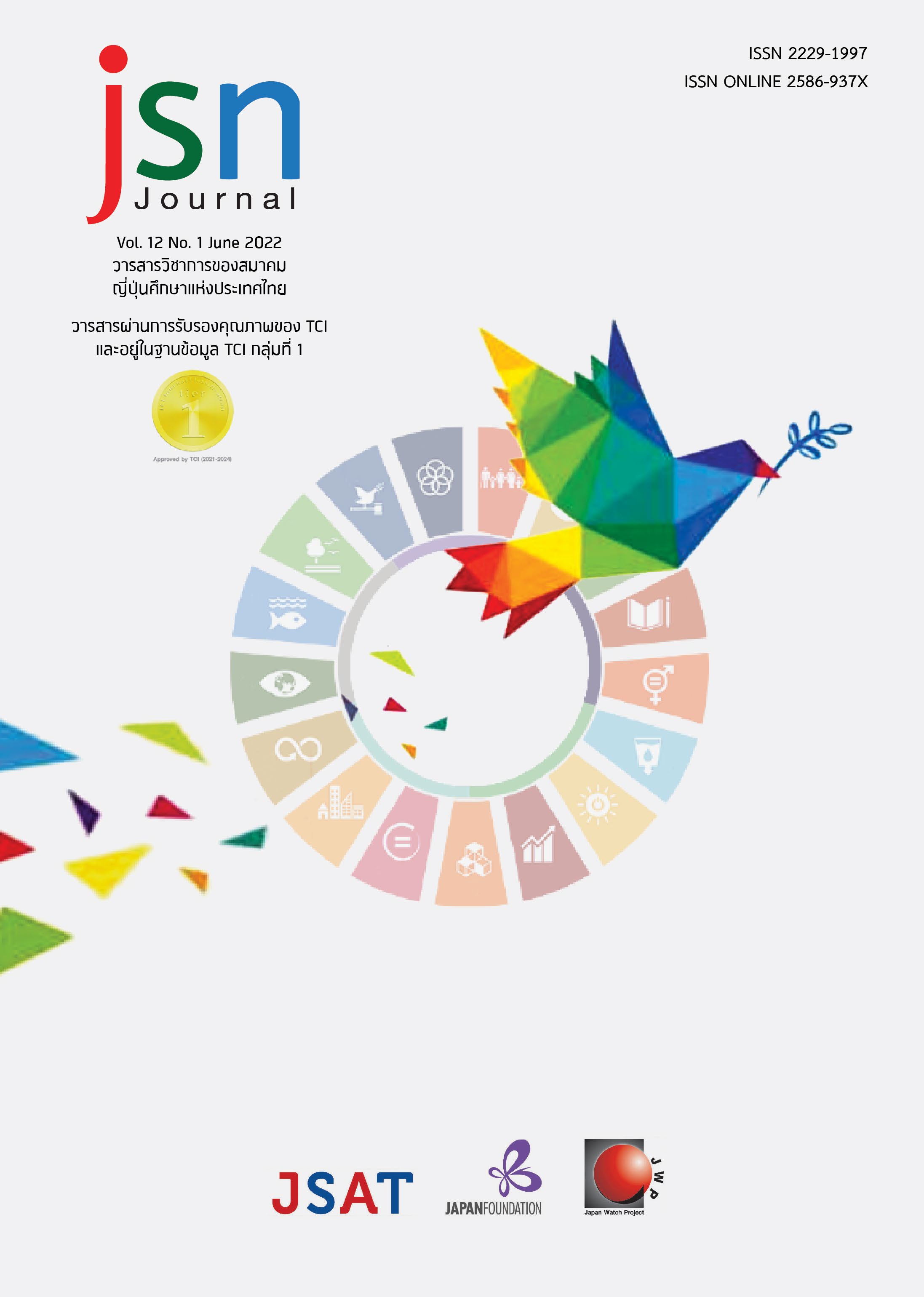Effects of Learning Activity Based on CMM and RT on Japanese Conversation Style
Main Article Content
Abstract
This research aimed to study the effects of the learning activity based on Coordinated Management of Meaning (CMM) and Reader’s Theatre (RT) on Japanese conversation style (共話 or Kyouwa). The sample of this study was 11 students who were eleventh-grade students majoring in Japanese from a secondary school in Bangkok. The research instruments were 1) a learning activity based on CMM and RT 2) an evaluation form to analyze students’ Japanese conversation style with rubrics scores. Descriptive statistics and Wilcoxon signed - rank test were used to compare the data. The findings revealed that the students’ Japanese conversation style of the post-test were significantly higher than the pre-test at .01 level (z = 2.956, p-value = 0.003). Speaker role’s data were significantly higher at .01 level in which 1) indirect disagreement and 2) turn-taking were higher respectively. Listener role’s data were significantly higher at .01 which 1) reaction phrase and 2) backchannels signals were higher respectively.
Article Details

This work is licensed under a Creative Commons Attribution-NonCommercial-NoDerivatives 4.0 International License.
ข้อความและข้อคิดเห็นต่างๆ ในบทความเป็นของผู้เขียนบทความนั้นๆ ไม่ใช่ความเห็นของกองบรรณาธิการหรือของวารสาร jsn Journal
References
จันทร์เพ็ญ ศักดิ์ชัยเจริญกุล. (2553). การศึกษารูปแบบและปัจจัยในการปรับระดับความสุภาพขณะสนทนาภาษาญี่ปุ่นของชาวไทยผู้รู้ภาษาญี่ปุ่นเปรียบเทียบกับชาวญี่ปุ่น. [วิทยานิพนธ์มหาบัณฑิต]. มหาวิทยาลัยธรรมศาสตร์.
ดวงใจ จงธนากร. (2557). Project-Based Learning กับการเรียนการสอนภาษาญี่ปุ่น. 国際交流基金バンコク日本文化センター日本語教育紀要, (11), 13-19.
ทัศนีย์ เมธาพิสิฐ. (2004). ปัญหาการเรียนภาษาญี่ปุ่นของนักศึกษาไทย. วารสารญี่ปุ่นศึกษา, 21(2), 35-70.
นะโอะโกะ โยะฌิดะ และ ทนพร ตรีรัตน์สกุลชัย. (2016). การศึกษาผลสัมฤทธิ์ทางการเรียนต่อการสอนแบบห้องเรียนกลับทาง รายวิชาภาษาญี่ปุ่นพื้นฐาน 1 ของนักศึกษาที่ไม่ใช่วิชาเอก มหาวิทยาลัยเชียงใหม่. วารสารเครือข่ายญี่ปุ่นศึกษา, 6(2), 71-83.
ไพลิน เจริญผล. (2555). รูปแบบภาษาที่ปรากฏตอนท้ายการขอร้องของผู้เรียนภาษาญี่ปุ่นชาวไทย:ผลสำรวจการใช้ภาษาของผู้เรียนในระดับมัธยมศึกษาและระดับอุดมศึกษา.[สารนิพนธ์หลักสูตรปริญญาอักษรศาสตรมหาบัณฑิตสาขาวิชาภาษาญี่ปุ่นเป็นภาษาต่างประเทศ].จุฬาลงกรณ์มหาวิทยาลัย.
พระอุดมธีรคุณ และ บัณฑิกา จารุมา. (2020). ภาษาและวัฒนธรรม: ความหมาย ความสำคัญ และความสัมพันธ์ระหว่างกัน. วารสารมหาจุฬาวิชาการ, 7(2), 53-63.
พัชราภา เอื้ออมรวนิช. (2560). การสื่อสารภายใต้มิติความหลากหลายทางวัฒนธรรมตามแนวคิด Geert Hofstede Communication through Multi-Cultural Dimensions of Geert Hofstede. วารสารวิชาการมนุษยศาสตร์และสังคมศาสตร์, 25(4), 223-240.
สำนักวิชาการและมาตรฐานการศึกษา สำนักงานคณะกรรมการการศึกษาขั้นพื้นฐาน กระทรวงศึกษาธิการ. (2551). ตัวชี้วัดและสาระการเรียนรู้ภาษาญี่ปุ่นและภาษาเยอรมัน ตามหลักสูตรแกนกลางการศึกษาขึ้นพื้นฐานพุทธศักราช 2551 กลุ่มการเรียนรู้ภาษาต่างประเทศ. สำนักงานคณะกรรมการการศึกษาขั้นพื้นฐาน กระทรวงศึกษาธิการ.
สุมาลี วังทรายทอง. (2560). การพัฒนากิจกรรมการเรียนเพื่อส่งเสริมความสามารถทางการเรียนภาษาญี่ปุ่นเบื้องต้นสำหรับนักเรียนชั้นมัธยมศึกษาปีที่ 4 โดยใช้รูปแบบการเรียนแบบร่วมมือเทคนิค TGT = The development of learning activities on basic Japanese language for grade 10th students using cooperative learning team game tournament technique. [วิทยานิพนธ์มหาบัณฑิต]. มหาวิทยาลัยบูรพา.
สุรีรัตน์ เรืองประยูร และ ปฏิยุทธ์ ธันวานนท์. (2017). การเรียนรู้วัฒนธรรมสมัยนิยมของญี่ปุ่นผ่านอนิเมชั่นและมังงะ ของนักศึกษายุคเจเนอเรชั่น Z คณะศิลปศาสตร์ หลักสูตรสาขาภาษาญี่ปุ่นธุรกิจ มหาวิทยาลัยธุรกิจบัณฑิตย์. วารสารเครือข่ายญี่ปุ่นศึกษา, 7(3), 88-102.
ยุพวรรณ โสภิตวุฒิวงศ์. (2018). การเปิดเผยตนเองในการสนทนาระหว่างผู้ที่เพิ่งรู้จักกัน: การศึกษาเปรียบเทียบระหว่างภาษาไทยกับภาษาญี่ปุ่น. วารสารเครือข่ายญี่ปุ่นศึกษา, 7(3), 1-17.
Adams, W. (2003). Readers theatre: A practical guide for school, theater, and community. San Diego, Ca: Institute for Readers Theatre.
Aoki, A. (2010). Rapport management in Thailand and Japanese Social Talk during Group Discussions. Pragmatics. International Pragmatics Association, 20(3), 289-313.
Augustin, A., & Vianty, M. Zuraida.(2015). Exploring the Potential of Reader's Theatre in the EFL Classroom. Journalof English Literacy Education, 2(2), 38-47.
Iwasaki, S., & Horie, P. I. (1998). The Northridge Earthquake' Conversations: Conversational Patterns in Japanese and Thai and their Cultural Significance. Discourse & Society, 9(4), 501-529.
Markova, V. (2011). The Japanese Communication Style. Scientific Grant Agency of the Ministry of Education of the Slovak Republik VEGA 10(1), 213-221.
Pearce, W. B., Cronen, V. E. (1980). Communication, action, and meaning: The creation of social realities. Praeger.
Rafi, M. F. (2019). Teaching Speaking with Reader’s Theatre. Journal ELink, 6(1), 127-133.
Rosen, R. S., & Koziol Jr, S. M. (1990). The Relationship of Oral Reading, Dramatic Activities, and Theatrical Production to Student Communication Skills, Knowledge, Comprehension, and Attitudes. Youth theatre journal, 4 (3), 7-10.
Sloyer, S. (1982). Readers Theatre: Story Dramatization in the Classroom. National Council of Teachers of English.
伊藤昭 & 矢野博之.(1998). 共話-創発的対話の対話モデル 情報処理学会研究報告音声言語情報処理 (SLP)』12, 1-8.
久保田真弓. 1994.「コミュニケーションとしてのあいづち―アメリカ人と日本人に見られる表現の違い―」 異文化間
教育』8, 59-76.
笹川洋子.(2007).「異文化コミュニケーション場面にみられる共話の類型」 神戸親和女子大学言語文化研究』1, 17-40.
田所希佳子. (2015)「『共話』の教育において学習者の認識に注目する重要性.『ヨーロッパ日本語教育シンポジウム (フランス) 第19回. ボルドー・モンテーニュ大学 (フランス) 2015年8月27-29日 225-230.
水谷信子. (1980).「「外国人の修得とコミュニケーション」『言語生活』12, 28-36.
水谷信子. (1993).「「共話」から「対話」へ」『日本語学』12 (4)、4-10.
劉佳珺. (2009).「多人数会話における共話的なインターアクションの分析-日本語母語場面と日中接触場面の対照」
ことばの科学』22,97-116.


